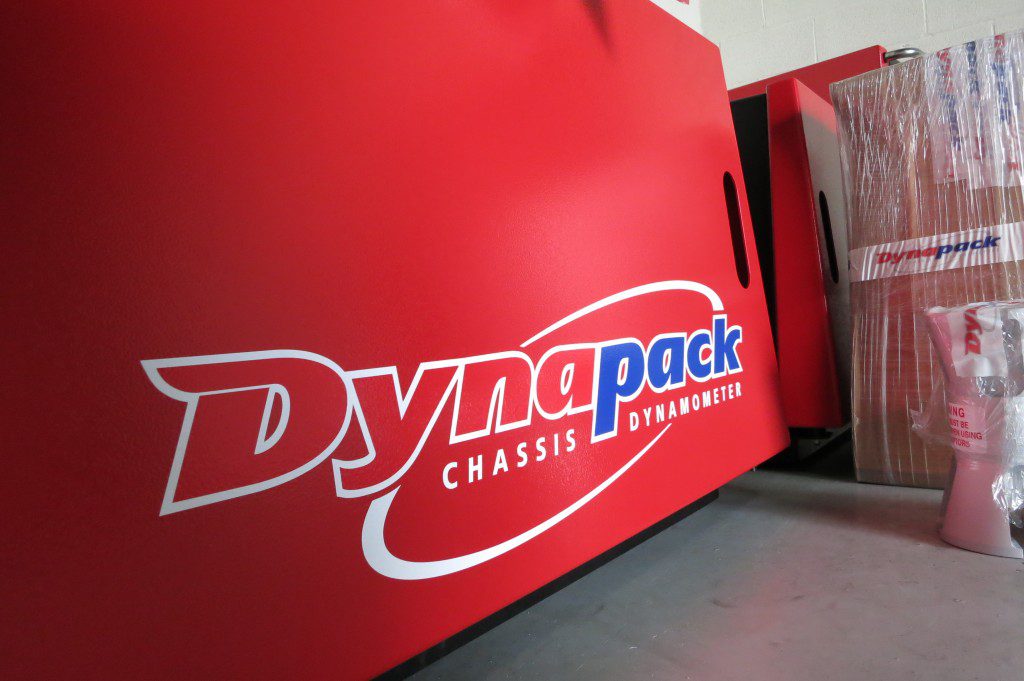The first and most obvious difference is the elimination of the tire to roller interface on a conventional roller dyno. The Dynapack eliminates this variable by using a hub adapter that provides a direct coupling to the Power Absorption Units. There can be no tire slip, no rolling resistance, and no chance of the vehicle coming off of the dyno at high speeds. Notice that this is called a variable. Sometimes it may be a problem area; other times it may not. Tire temperature, pressure, traction, etc., are all variables that can change, not only from run to run, but also during the run. Throw an unknown variable like this into the equation and your data has now become subject to a potentially high margin of error. It is obviously better if these variables are eliminated, which is exactly what we have done. There are other associated problems with the roller method as well. Take tie-down straps for example. Most roller dynos use ratcheting tie-down straps to attempt to hold the vehicle in position while being tested. If the straps are cinched down tightly, the tire has become loaded even further in an unpredictable manner. While this may be good for enhancing traction, it changes the rolling resistance of the tire, skewing the data even more. Since these tie-down straps aren’t perfect, the vehicle squirms around on the rollers dramatically changing the tire drag during the run. If the vehicle is tested in two different sessions, the straps can’t be set exactly the same way twice. Again, the data will be inconsistent. There have been cases where the ratcheting tie-down straps were loosened by two clicks and the measured power increased by ten horsepower. What if the straps stretch, either from run to run or during the run itself? Wouldn’t it be great if all of these problems could disappear? With a Dynapack, they were never there in the first place.
Another major difference is the effect of inertia
Street wheels and tires spinning at high RPM have a large amount of inertia. A large steel drum spinning at the same ground speed has much more inertia. What you end up with is a giant, heavy flywheel attached to your engine. The inertia is such that just trying to accelerate the mass of the roller is a substantial load for the engine. That is the principle that some roller dynos (or “inertia dynos” as they are also called) operate on–accelerate a known mass to a measured speed over a given time and it can be calculated to equal a certain amount of power. There is nothing wrong with this theory, but like many theories, its application in the real world can be troublesome. How do you think measurements will be effected by being subjected to this large heavy flywheel phenomenon? Will small fluctuations be noticeable? In a word, no. The flywheel effect tends to take small, rapid variations and smooth them right out; energy that should be going into the dyno is being wasted trying to accelerate a large lump of steel. This is great if you want your power curve to look like a smooth pretty line, but it doesn’t give you much insight into what is really occurring. What if the flywheel effect was eliminated? While nothing that has a spinning mass has “no” inertia, when compared to the total mass of the wheels, tires, rollers, and other associated hardware of a roller dyno, the inertia of a Dynapack is practically zero. This allows tiny rapid pulses and oddities that you may not have seen before to be precisely measured and displayed. Now there is a window into areas that no roller dyno will allow you to see. Another benefit of having virtually zero inertia is the ability to change the rate of acceleration at will. In many situations, you may want to accelerate the vehicle at a different rate to simulate a specific condition. With a few simple keystrokes, Dynapack allows you to make the vehicle accelerate very quickly, slowly, or anywhere in between. Because of the lack of inertia and the total control of the engine speed, Dynapack gives you choices that none of the competitors can even dream of.
| Repeatability Dynapack dyno runs are repeatable to better than 0.3%. Other dyno manufacturers claim to be repeatable, but no other chassis manufacturer is even close to the level of repeatability the Dynapack achieves. One large reason for this is because the largest variable of all has been eliminated–the tire to roller interface. Rubber tires don’t hold traction against a steel roller very well. Add a year or so of use, and the rollers become polished by the tires and traction decreases further. When you have this variable link in your data chain, you cannot have guaranteed repeatability–PERIOD. Sure a roller dyno itself may be repeatable, but as soon as you put a car on it, all bets are off. Many people think that this slippage only occurs in high power situations, but we’ve seen it happen with 250HP Hondas. Just ask some of the import tuners who have had guys sitting on the hood and fenders trying to get the tires to hook up. With the Dynapack, there is a direct mechanical coupling to make absolutely sure that there is no loss, no slippage, and no inconsistencies in this area. There is virtually no inertia to mask small details and the Dynapack uses hydraulics for ultimate sensitivity and precision. The Dynapack is absolutely the most consistent and repeatable chassis dyno in the world. |
| Sensitivity Minute differences that are not seen on other machines can be reliably measured.
|



